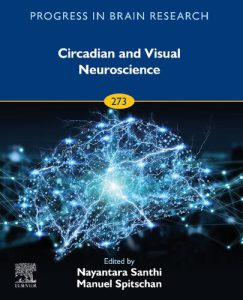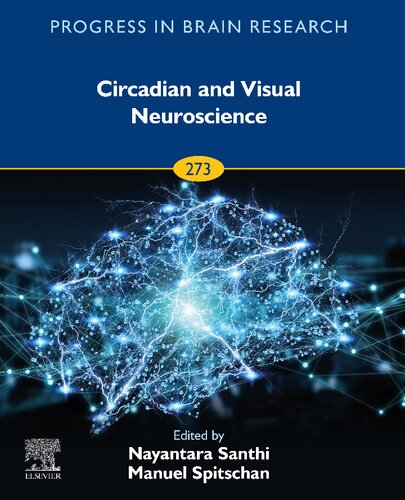Circadian and Visual Neuroscience 1st Edition by Nayantara Santhi 9780323859448 0323859445
$50.00 Original price was: $50.00.$25.00Current price is: $25.00.
Circadian and Visual Neuroscience 1st Edition Nayantara Santhi – Ebook Instant Download/Delivery ISBN(s): 9780323859448, 0323859445

Product details:
- ISBN 10:0323859445
- ISBN 13:9780323859448
- Author: Nayantara Santhi
Circadian and Visual Neuroscience
Circadian and Visual Neuroscience, Volume 273 in the Methods in Enzymology series, highlights new advances in the field with this new volume presenting interesting chapters on topics including Optical set-ups, Psychophysics of Luminance and Color Vision, Psychophysics of non-visual photoreception PRC/IRC/DRC/Spectral Sensitivity, Circadian and visual photometry, Modelling (retina), Modelling (circadian), Techniques for examining vision at the cellular level, Advanced techniques for characterizing the world hyperspectrally, Circadian physiology in mice: Melanopsin, Circadian physiology in mice: Color and cones, Translational aspects of animal studies, Retinal clocks, Primate non-visual physiology, Light and mood in animal models, and much more.
- Provides the authority and expertise of leading contributors from an international board of authors
- Presents the latest release in Progress in Brain Research series
- Updated release includes the latest information on Circadian and Visual Neuroscience
Table contents:
Chapter 1: Circadian and visual photometry
Abstract
1: The basis of physical photometry
2: Colorimetry
3: IIL responses
4: Conclusions
References
Chapter 2: Optical stimulation systems for studying human vision
Abstract
1: Introduction
2: Optical stimulation systems
3: Characterization and calibration principles
4: Conclusions
References
Chapter 3: Hyperspectral characterization of natural lighting environments
Abstract
1: Introduction
2: Method
3: Application
4: Conclusion
Acknowledgment
References
Further reading
Chapter 4: Endogenous functioning and light response of the retinal clock in vertebrates
Abstract
1: Introduction
2: Molecular organization of the retinal clock in vertebrates
3: Cellular organization of the retinal clock in vertebrates
4: Retinal circadian rhythms
5: The light response of the retinal clock
6: Future directions
Acknowledgments
References
Chapter 5: Light-dependent effects on mood: Mechanistic insights from animal models
Abstract
1: Introduction
2: Light detection pathways and effects on physiology in mammals
3: Effects of light on mood in humans
4: Animal models
5: Mood alterations induced by light-dependent disruption of circadian rhythms
6: Direct effects of light
7: Bright light therapy
8: Discussion
References
Chapter 6: Rodent models in translational circadian photobiology
Abstract
1: Introduction
2: The role of rodent models in circadian photobiology
3: Translational circadian photobiology
4: Strengths and limitations of rodent models
5: Future directions
6: Conclusions
Acknowledgments
References
Chapter 7: Slow vision: Measuring melanopsin-mediated light effects in animal models
Abstract
1: Introduction
2: Methods of studying melanopsin at a systems level
3: Melanopsin contribution to nonimage-forming function: Methods and findings
4: Closing remarks
Acknowledgments
References
Chapter 8: Beyond irradiance: Visual signals influencing mammalian circadian function
Abstract
1: Introduction
2: Experimental paradigms providing insight into the photoentrainment mechanism
3: Evidence for inner and outer retinal sources of circadian control
4: Retinal photoreceptor specializations
5: Rod contributions to circadian photoentrainment
6: Cone contributions to circadian photoentrainment
7: Spatiotemporal properties of circadian responses
8: Do insights into rodent photoentrainment translate to humans?
9: Conclusion
References
Chapter 9: Circadian photoreception: The impact of light on human circadian rhythms
Abstract
1: Phase response curve
2: Duration sensitivity
3: Intensity response curve
4: Spectral sensitivity
References
Chapter 10: Modeling (circadian)
Abstract
1: Introduction
2: Foundational aspects of modeling the circadian system
3: Representation of light in models of the circadian system
4: Application of mathematical models to improve human health and performance
5: Conclusions
References
Chapter 11: Visual encoding: Principles and software
Abstract
1: Introduction
2: Representing the scene radiance
3: Optics: The retinal irradiance
4: Light transduction
5: Example calculations
6: Summary
References
Chapter 12: Visual psychophysics: Luminance and color
Abstract
1: Introduction
2: Psychophysical methods
3: Selected results
4: Final thoughts & resources
Acknowledgments
References
Chapter 13: Aging of visual mechanisms
Abstract
1: Introduction
2: Optical changes associated with aging
3: Senescent changes in sensitivity of rod and cone pathways
4: A note about unconscious visual processes
References
Chapter 14: Seeing and sensing temporal variations in natural daylight
Abstract
1: Measurements of natural illumination over time
2: The dual human response to light
3: Measuring perception of temporal variations in illumination
Acknowledgments
References
Chapter 15: Light in ecological settings: Entrainment, circadian disruption, and interventions
Abstract
1: Introduction
2: Entrainment in humans: Light as the dominant zeitgeber
3: Circadian disruption: How misaligned light-dark cycles can disrupt the circadian system
4: Field studies: Using light to mitigate effects of circadian disruption in ecological settings
5: Conclusion
References
Chapter 16: How can light be used to optimize sleep and health in older adults?
Abstract
People also search:
circadian and visual neuroscience
vision issues while driving at night
what part of the brain controls circadian rhythm
what is visual neuroscience
what part of the brain circadian rhythm
You may also like…
Medicine - Neuroscience
Medicine - Neuroscience
Uncategorized
Circadian Regulation Methods and Protocols Methods in Molecular Biology 2482 Guiomar Solanas
Computers - Applications & Software
Neuroscience and Computational Intelligence 1st Edition Jovan Pehcevski
Science (General) - Theories of Science
Neuroscience and Philosophy by Felipe De Brigard; Walter Sinnott-Armstrong 0262367335 9780262367332












